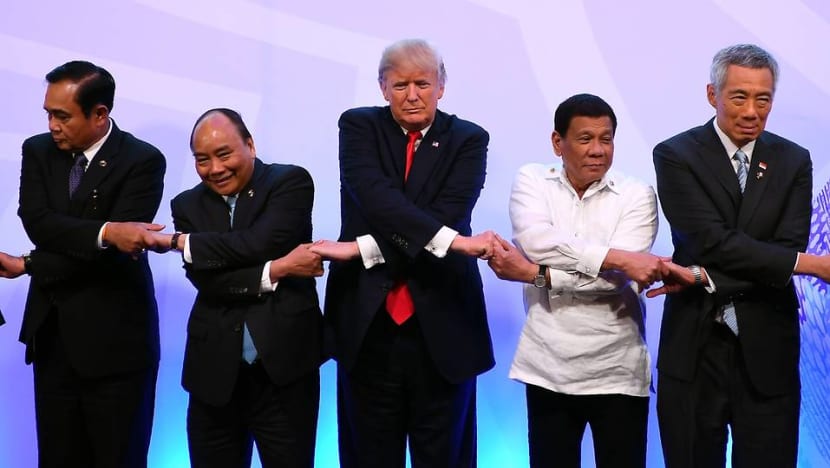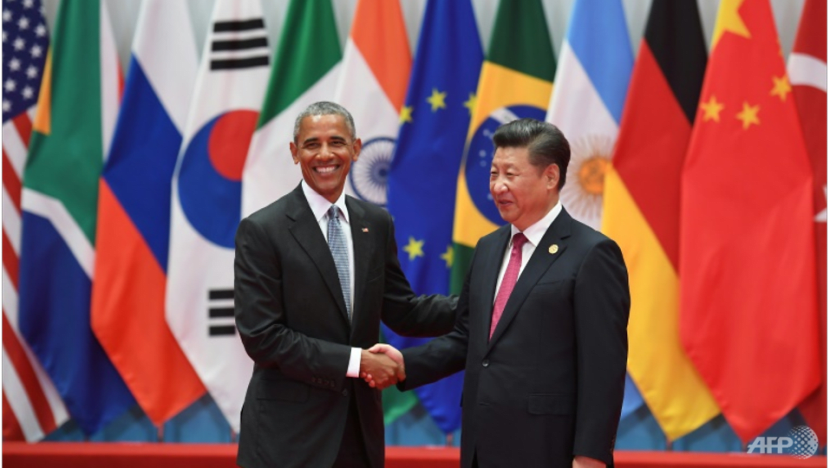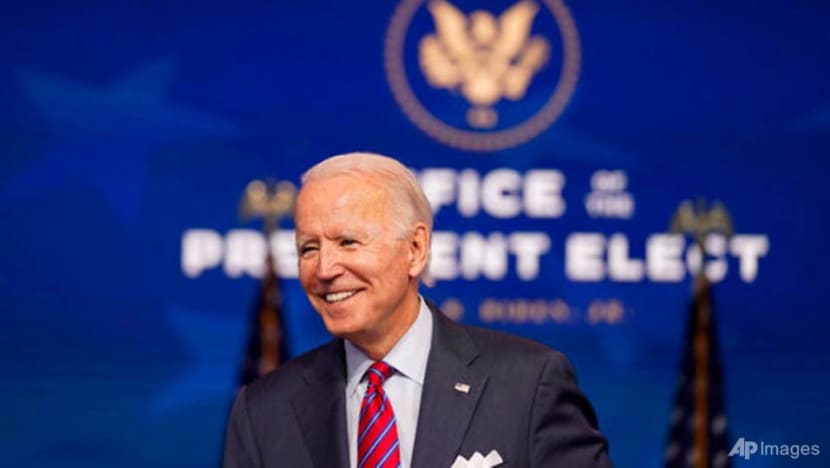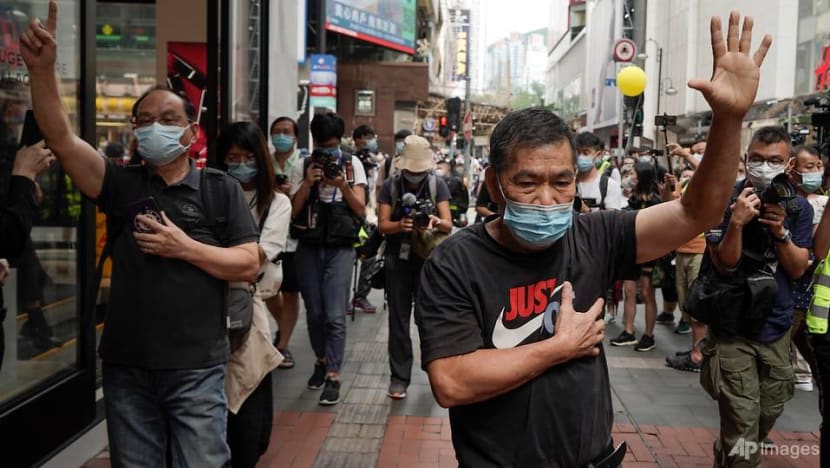commentary Commentary
Commentary: Parts of Asia will miss Donald Trump’s tough China policy
While some countries fear an Obama 2.0 under Joe Biden, there are measures the new US president can take to boost confidence in the region, says Ted Gover.

US President Donald Trump and ASEAN leaders at the ASEAN-US 40th Anniversary commemorative Summit. (Photo: AFP/POOL/MANAN VATSYAYANA)
CLAREMONT, California: As Joe Biden prepares to assume the US presidency, there is much unease and ambiguity about America’s traditional role as the Asia-Pacific’s security guarantor.
As much as President Donald Trump’s time in office was challenging for partners, many Asian states appreciated his “get tough” approach on China and fear the new administration will return to a middling policy under Biden’s former boss Barack Obama.
Biden’s assumption of the presidency comes at a time when China’s growing influence and assertive actions have provoked unease in Asia, especially among those carefully watching its moves in Xinjiang, Taiwan, Hong Kong and the South China Sea.
READ: Commentary: It’s engagement not containment of China that Joe Biden will focus on
READ: Commentary: Joe Biden takes office in pivotal moment for climate action. Can he deliver?
These views regarding a rising China are reflected in Pew Research’s Summer 2020 Global Attitudes Survey of advanced economies. Distrust in Xi Jinping has reached unprecedented heights with 78 per cent of respondents stating they do not have confidence in Xi to do the right thing in world affairs.
This in part explains why Trump’s willingness to stand up to China on technology, trade and more had been welcomed by countries in the Asia-Pacific who were willing to set aside misgivings regarding his “America First” policy and his conduct in office.
Reports leading up to the US election highlighted the strong support residents in Asia-Pacific countries – including Vietnam, Japan and South Korea - have for Trump, who they say has managed to provide a strong counterweight to China economically, militarily and strategically.
LISTEN: US election: A bitter fight for the soul of the world's most powerful nation
OBAMA’S HESITANCE OVER COUNTERING AGGRESSIVE CHINESE BEHAVIOUR
To be fair, Obama’s considerable diplomatic skills, childhood upbringing in Indonesia and poise made him personally beloved in Asia and provided American “soft power” in abundance.
Yet, regional countries became uncomfortable with what they saw as Obama’s penchant for accommodation rather than engagement in the face of China’s aggressive behaviour.

Part of this might have been legacy challenges, as the administration focused on drawing down troops from Iraq and Afghanistan. Obama also had his hands full with North Korea, Libya, the rise of the Islamic State as well as domestic political battles in Washington.
But part of it might also have been muddling, as US foreign policy failed to define its relationship with China and how it would engage Asia. While aspiring towards a “pivot to Asia”, Obama failed to couple an increased American military presence in the Asia-Pacific with a robust response to China’s militarisation of the South China Sea.
Some attribute naiveté to Obama, a man who had never visited China prior to assuming the presidency, for thinking the Chinese Communist Party could be won over by diplomacy primarily.
READ: Commentary: A US led by Joe Biden will focus on Asia and China
The costs have been keenly felt in other aspects of the US-Asia relationship. Observers point to his failure to secure support for the Trans-Pacific Partnership (TPP), which ceded further trade and economic influence to China.
They also highlight Obama’s inability to cement needed World Trade Organization (WTO) reforms and the inefficacy of his “strategic patience” approach in stemming the advance of North Korea’s nuclear weapons programme.
READ: Commentary: Assassinating top scientist makes killing Iran's nuclear programme harder
BIDEN SHOULD BUILD ON TRUMP’S APPROACH AND FOCUS ON THE SOUTH CHINA SEA
Biden must tackle these concerns head on by making the case that American strategic and economic leadership offers the region a future of shared prosperity and security.
The President-elect can do this with deeds, not just words.
To begin, President-elect Biden should push back against China’s attempts to shift the balance of power in the South China Sea. This must be a multi-pronged approach.

First, he must apply diplomatic, security and economic pressure on China through “the Quad”, the US-India-Japan-Australia partnership geared towards supporting a free and open Indo-Pacific.
Operations to demonstrate the US military’s presence, such as FONOPS – freedom of navigation operations – to challenge Beijing’s expansive maritime claims, as well as joint air-sea drills like the yearly Exercise Malabar naval exercises in the Bay of Bengal and the Balikatan “shoulder-to-shoulder” military exercises in the Philippines should continue, whether under the Quad or otherwise.
READ: Commentary: After years of demonising China, the US has to start an honest dialogue
BIDEN SHOULD INVEST IN REGIONAL MILITARY DETERRENCE
Second, Biden must pursue enhanced military deterrence by bolstering US military capabilities in the Pacific to address new areas of vulnerability resulting from China's island-building campaign and denial strategy designed to push US forces outside of the first and second island chains.
While President Trump rightly increased military spending to make up for costly defence budget decreases during the Obama administration, the US Navy still has insufficient vessels to meet regional commitments.
Biden’s first defence budget ought to include money for the navy to increase shipbuilding of sufficient numbers and quality to continue to allow for the US to operate beyond the second island chain in the Pacific.
READ: Commentary: Biden needs to build bridges, literally, in the US
This will involve appropriations for an increased number of undersea warfare assets such as submarines, as well as frigates, unmanned vessels and ships with enhanced stealth technologies.
Additional needed areas of funding support involve radar and hypersonic weapons systems, intelligence-sharing centres with partners in Southeast Asia and Oceania, more frequent deployments of increased numbers of forces and measures to fortify existing US facilities in Japan, South Korea and Guam.
The Biden administration should also continue and build upon ongoing efforts by Tokyo and Washington to provide naval, guard coast and air assets to Asia-based partners who lack needed capabilities to protect their own domains - in particular, the Philippines, Indonesia and Vietnam.

Washington's current missile gap with Beijing must also be filled. In recent years, China has built the world's largest arsenal of short and intermediate-range ballistic and cruise missiles designed to destroy aircraft carriers as well as US bases in Japan, South Korea and Guam.
These necessary military outlays come amid rising budgetary pressures relating to America’s damaged economy and the domestic priorities Biden advocated during the campaign.
Yet, Biden needs to exert leadership with his counterparts in Congress and make the case for the needed military spending during this current opportune time of low interest rates.
READ: Commentary: The world has big expectations for a Joe Biden presidency
USING ECONOMIC SANCTIONS WHEN NECESSARY
Third, Biden’s team can also take a page from Trump’s playbook on the use of economic incentives and sanctions vis-a-vis Beijing.
While a new trade deal with China may be politically sensitive during the early days of the new Biden administration, he can use Trump’s existing US tariffs on Chinese goods as leverage in future trade negotiations.
Biden could also use increased tariffs or sanctions on select Chinese companies or Chinese Communist Party officials as punishment when occasions warrant, such as future acts of aggression at sea.
READ: Commentary: After a stormy few years, verdict on Trump’s trade war with China is clear
Fourth, although President Trump was often criticised for not advocating for human rights as much as his critics wanted, his administration did speak out against Beijing’s actions in Hong Kong and its treatment of Uighur Muslims in Xinjiang.
The Biden administration ought to do the same and should apply the bipartisan Global Magnitsky Act - which authorises the US government to sanction human rights offenders - to officials involved in human rights violations.

Biden should also continue other facets of Trump’s China policy such as his tough stand on 5G technologies to protect American data; lessen reliance on China for pharmaceuticals and personal protective equipment; and express solidarity with India amid Beijing’s land grabs in the Galwan Valley.
RAMPING UP MULTILATERAL ENGAGEMENTS
Not all of Trump’s foreign policy were appreciated. His absence from most of the yearly multi-country forums in Asia damaged America’s credibility on multilateralism.
President-elect Biden and key cabinet officials should attend these regional summits the US is invited to – including relevant forums led by the Association of Southeast Asian Nations (ASEAN), as well as the East Asia Summit and the Asia-Pacific Economic Cooperation (APEC) - to shape the agenda.
Key US ambassadorships, such as for ASEAN and Singapore, must be filled. President-elect Biden, his Secretary of Defense and incoming Secretary of State Tony Blinken should meet their counterparts in the region with greater frequency.
READ: Commentary: America has a chance to repair diplomacy. Don't squander it
Although reports of Biden’s plan to appoint an “Asia Tsar” is a good start, more Asia hands should be brought in to fill posts at the National Security Council, the Departments of State, Defense, Justice as well as the Office of the US Trade Representative.
Additionally, Biden’s team should find ways to join the now evolved TPP trade block to reassert US influence in Asia and help shape the trade norms of the next generation.
Along these lines, the new US International Development Finance Corporation and the US Export-Import Bank need to orient their operations to focus on the long-term infrastructure investment and economic development needs of the broader region.
READ: Commentary: Joe Biden will not be able to unify the US
It bears saying that Washington and its Asian partners ought to encourage China to be a constructive force and work to bring the best out of its leadership. When possible, the US must seek engagement, and avoid a blind anti-China posture which will only sideline moderates and embolden Chinese Communist Party hardliners.
Above all, President-elect Biden must understand that America’s friends in Asia prefer he avoid the overly cautious China policy of his former boss and adopt some of Trump’s more sensible measures.
Ted Gover writes on foreign policy and is the Director of the Tribal Administration Program at Claremont Graduate University.














